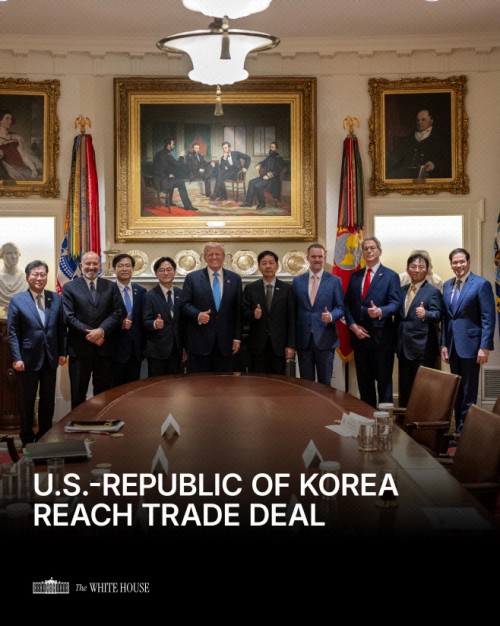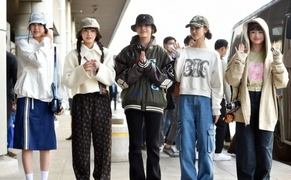 |
| U.S. President Donald Trump (fifth from left) poses for a group photo with South Korean Deputy Prime Minister and Finance Minister Koo Yoon-cheol (sixth from left), Trade Minister Kim Jung-kwan (fourth from left), and Trade Negotiations Minister Yeo Han-goo (third from left) during Korea-U.S. trade talks at the White House on July 30. Also pictured are U.S. Secretary of State Marco Rubio (far right), Treasury Secretary Scott Besant (third from right), U.S. Trade Representative Jamison Greer (fourth from right), and Commerce Secretary Howard Lutnick (second from left). / Source: White House X |
The White House has confirmed that South Korean President Lee Jae-myung and U.S. President Donald Trump will hold their first summit on August 25 in Washington, D.C., amid expectations that the Trump administration could press Seoul for a significant increase in defense spending and its share of U.S. Forces Korea costs.
According to Reuters on August 11, a White House official confirmed the summit, which will include an official lunch meeting. Earlier, South Korea’s presidential spokesperson Kang Yoo-jung announced that President Lee will visit the U.S. from August 24 to 26 at Trump’s invitation.
Since winning the presidential election on June 3, Lee has made responding to the rapid shifts in the global trade environment triggered by Trump’s tariff policies a top priority, Reuters reported.
On July 30, the two nations reached a trade deal at the White House, agreeing to cut planned U.S. tariffs on Korean goods from 25 percent to 10 percent in exchange for South Korea pledging $350 billion in investments in sectors designated by Trump. Of that, $150 billion will go to the “Make American Shipbuilding Great Again” (MASGA) initiative. However, the two governments differ on how the remaining $200 billion in investment returns should be used — Seoul calling it “reinvestment” while Washington says it will go toward U.S. debt repayment or Trump-selected sectors — setting the stage for possible disputes.
Experts told Reuters that Trump could use the summit to seek additional concessions from South Korea on defense spending and cost-sharing for U.S. troops, as well as raise non-tariff barrier and currency issues. Trump has long argued that South Korea should pay around $10 billion annually — roughly 10 times the current amount — for the stationing of about 28,500 U.S. troops.
The Washington Post reported on August 9 that the Trump administration wants South Korea to increase its defense budget from 2.6 percent to 3.8 percent of GDP and pay an additional $1 billion in cost-sharing.
Jeremy Chan, senior analyst at Eurasia Group, said it is unclear whether Trump will raise these issues personally, but at a minimum, working-level talks are expected to expand from trade and investment into broader alliance matters. “I think there’s a much greater chance that Trump and his team will at least quietly bring up issues related to the security alliance,” Chan said. “That could lead to pressure on President Lee to increase the defense share in government spending.”
Most Read
-
1
-
2
-
3
-
4
-
5
-
6
-
7





















